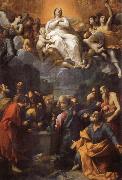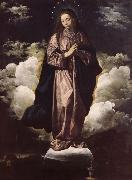Wholesale Oil Painting Reproductions No Minimum and Door to Door! |
|||||||||||
|
|
|||||||||||

|
|||||||||||
|
|
|
||||||||
All Guido Reni Oil Paintings |
||||||||
|
|
||||||||
|
|
||||||||
|
Artist Introduction: 1575-1642
Italian
Guido Reni Galleries
Born in Bologna into a family of musicians, Guido Reni was the son of Daniele Reni and Ginevra de?? Pozzi. As a child of nine, he was apprenticed under the Bolognese studio of Denis Calvaert. Soon after, he was joined in that studio by Albani and Domenichino. He may also have trained with a painter by the name of Ferrantini. When Reni was about twenty years old, the three Calvaert pupils migrated to the rising rival studio, named Accademia degli Incamminati (Academy of the "newly embarked", or progressives), led by Lodovico Carracci. They went on to form the nucleus of a prolific and successful school of Bolognese painters who followed Annibale Carracci to Rome. Like many other Bolognese painters, Reni's painting was thematic and eclectic in style.
By late 1601, Reni and Albani had moved to Rome to work with the teams led by Annibale Carracci in fresco decoration of the Farnese Palace. During 1601-1604, his main patron was cardinal Sfondrato. By 1604-1605, he received an independent commission for an altarpiece of the Crucifixion of St. Peter. After a few year sojourn in Bologna, he returned to Rome to become one of the premier painters during the papacy of Paul V (Borghese). From 1607-1614, he was one of the painters patronized by Borghese.
Abduction of Deianira, 1620-1621.Reni's frescoed ceiling of the large central hall of garden palace, Casino dell'Aurora located in the grounds of the Palazzo Pallavicini-Rospigliosi, is considered his masterpiece. The casino was originally a pavilion commissioned by Cardinal Scipione Borghese; the rear portion overlooks the Piazza Montecavallo and Palazzo del Quirinale. The massive fresco is framed in quadri riportati and depicts Apollo in his Chariot preceded by Dawn (Aurora) bringing light to the world. The work is restrained in classicism, copying poses from Roman Sarcophagi, and showing far more simplicity and restraint than Carracci's riotous Triumph of Bacchus and Ariadne[5] in the Farnese. Reni in this painting is allies himself more with the sterner Cavaliere d'Arpino,Lanfranco, and Albani "School" of mytho-historic painting, and less with the more crowded frescoes characteristic of Pietro da Cortona. There is little concession to perspective, and the vibrantly colored style is antithetical to the tenebrism of Caravaggio's followers. Payments showed that he was paid in 247 scudi and 54 baiocchi upon completion on 24 September 1616.
He also frescoed in Paoline Chapel of Santa Maria Maggiore in Rome as well as the Aldobrandini wings of the Vatican. According to rumor, the pontifical chapel of Montecavallo (Chapel of the Annuciation) was assigned to Reni to paint. However, because he felt underpaid by the ministers, the artist left for Bologna, leaving the role of the preeminent artist in Rome to Domenichino. |
||||||||
|
|
||||||||
|
Assumption Painting ID:: 30546 |
mk68
Oil on canvas
15'6"x9'3"
Genoa,Church of Sant'Ambrogio
1616-1617
Italy
|
|||||||
Height Width |
INS/CM Quality |
|||||||
|
X |
| |||||||
|
|
||||||||
All Titian Oil Paintings |
||||||||
|
|
||||||||
|
|
||||||||
|
Artist Introduction: Italian High Renaissance Painter, ca.1485-1576
Italian painter active in Venice. As a young man he was taught by the Bellini family and worked closely with Giorgione. His early works are so similar in style to Giorgione's as to be indistinguishable, but soon after Giorgione's early death Titian established himself as the leading painter of the Republic of Venice. Among his most important religious paintings is the revolutionary and monumental Assumption (1516 ?C 18) for Santa Maria dei Frari, in which the Virgin ascends to heaven in a blaze of colour accompanied by a semicircle of angels. Titian was also interested in mythological themes, and his many depictions of Venus display his work's sheer beauty and inherent eroticism. Bacchus and Ariadne (1520 ?C 23), with its pagan abandon, is one of the greatest works of Renaissance art. Titian was sought after for his psychologically penetrating portraits, which include portrayals of leading Italian aristocrats, religious figures, and Emperor Charles V. He reached the height of his powers in The Rape of Europa (c. 1559 ?C 62), one of several paintings done for Philip II of Spain. He was recognized as supremely gifted in his lifetime, and his reputation has never declined. |
||||||||
|
|
||||||||
|
|
Assumption Painting ID:: 56830 |
mk250 Venice, Italy, the glory of Free Church of Our Lady, about the year in 1516-1518. Canvas board, 685.8 x 360.7 cm. |
||||||
Height Width |
INS/CM Quality |
|||||||
|
X |
| |||||||
|
|
||||||||
All Velasquez Oil Paintings |
||||||||
|
|
||||||||
|
|
||||||||
|
Artist Introduction: 1599-1660,Spanish painter. He was apprenticed to Francisco Herrera the Elder before being trained by Francisco Pacheco. His early works were mostly religious or genre scenes. After arriving in Madrid in 1623, he painted a portrait of Philip IV that won him immediate success and an appointment as court painter. His position gave him access to the royal collections, including works by Titian, who exerted the greatest influence on his style. In his portraits from this period, only the faces and hands of the figures are accentuated, and the dark figures stand out against a light background. A visit to Italy (1629 ?C 31) further developed his style, and on his return to Madrid he entered his most productive period. Velazquez created a new type of informal royal portrait for Philip hunting lodge, and his portraits of court dwarfs display the same discerning eye as those of his royal subjects. On a second visit to Rome (1649 ?C 51) he painted a portrait of Pope Innocent X. The powerful head, brilliant combinations of crimson of the curtain, chair, and cope are painted with fluent technique and almost imperceptible brushstrokes that go far beyond the late manner of Titian and announce the last stage in Velazquez development. This portrait was copied innumerable times and won him immediate and lasting renown in Italy. In his last years he created his masterpiece, Las Meninas (The Maids of Honour, 1656). In this casual scene, the artist is shown painting the king and queen in the presence of the infanta Margarita and her attendants; the nearly life size figures are painted in more or less detail according to their relation to the central figure of the infanta and to the source of light, creating a remarkable illusion of reality never surpassed by Velazquez or any other artist of his age. He is universally acknowledged as one of the giants of Western art. |
||||||||
|
|
||||||||
|
|
Assumption Painting ID:: 59501 |
mk267 1618 years linen canvas 135 x 101.6 cm London, National Gallery collection |
||||||
Height Width |
INS/CM Quality |
|||||||
|
X |
| |||||||
|
|
||||||||
All Samuel Palmer,OWS Oil Paintings |
||||||||
|
|
||||||||
|
|
||||||||
|
Artist Introduction: 1805-1881
|
||||||||
|
|
||||||||
|
|
Assumption Painting ID:: 62320 |
1695-96 Oil on canvas, 77,5 x 110 cm Museo de Bellas Artes, Bilbao This painting is an oil sketch of the fresco which Palomino painted in 1696 in the Oratory of the Town Hall in Madrid. Palomino painted two other frescoes representing the same subject, both destroyed, one in the chapel of the San Juan de Dios hospital, and another in the El Paular Carthusian monastery near Segovia |
||||||
Height Width |
INS/CM Quality |
|||||||
|
X |
| |||||||
|
|
||||||||
|
Prev Next
|
||||||||
|
|
||||||||
|
Related Paintings to Samuel Palmer,OWS :. |
||||||||
|
|
||||||||
|
CONTACT US |




